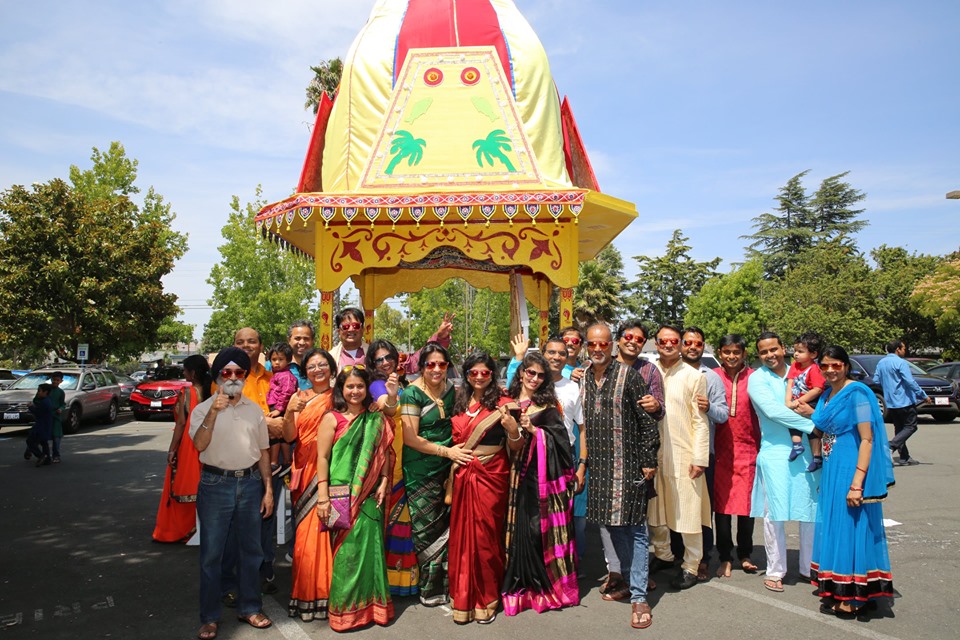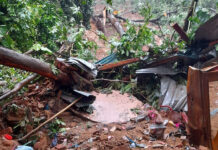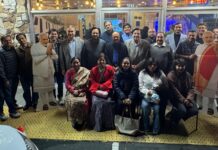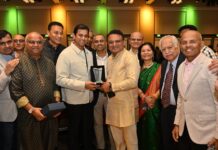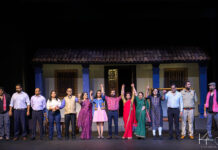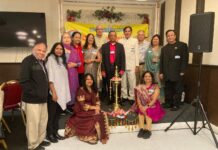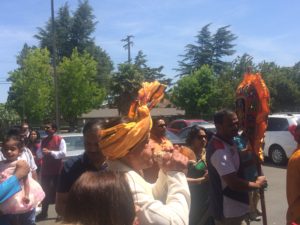 LAKSHMI IYER
LAKSHMI IYER
India Post News Service
FREMONT, California: The much anticipated Lord Jagannath Rath Yatra took place at the Vedic Dharma Samaj Fremont Hindu Temple in Fremont, California, July 6.
Fremont Hindu Temple and members of Odia Community in Bay Area put together this successful Ratha Yatra. This was coordinated by Mahesh Pakala & Reena Patnaik Rao, natives from Odisha. Sanjib Mohanty and Priyadarshy Dash provided valuable mentorship and support to the team. Several experienced and new volunteers/sevaks from the Odia community participated in this much awaited Odia event of the year. Mahesh says “Ratha Jatra at Fremont Hindu Temple was initiated by our dear Deba Mohanty with other Odia senior members. Over the years it has been established and this year we got the opportunity to coordinate. It was a blessing for all of us to serve Lord Jagannath along with the community at large.”
Among local dignitaries who attended the event were Fremont Mayor Lily Mei, Vice Mayor Raj Salwan, Fremont Council members Yang Shao and Vinnie Bacon and California State Assemblyman Kansen Chu.
California State Assembly member Ash Kalra also sent a certificate of recognition for the event although he could not attend.
The rituals started worship of the main deity at the temple 9.30 a.m. to 10 a.m. Later, devotees carried the idols from the main temple to the chariot (Rath) standing outside, one by one.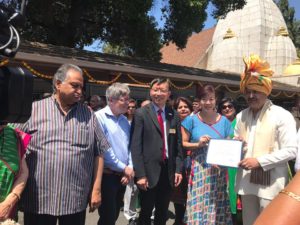
First was Lord Balabhadra, Lord Krishna’s older brother. The devotees chanted “Jai Jagannath” and “Jai Balram” as they lifted the heavy idol and carried it through the main temple hall and the outer corridor on to the Rath.
Next was Krishna’s sister, Goddess Subhadra. This time, women devotees carried the goddess from the sanctum sanctorum through the main temple hall and corridor to the Rath.
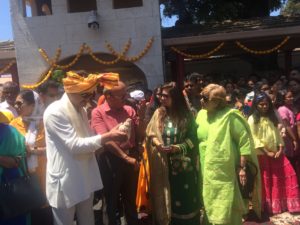 Last came Lord Jagannath himself. Devotees first circled around the central shrine where the Jagannath sanctum sanctorum is located and then proceeded along the same route as Lord Balabhadra and Goddess Subhadra.
Last came Lord Jagannath himself. Devotees first circled around the central shrine where the Jagannath sanctum sanctorum is located and then proceeded along the same route as Lord Balabhadra and Goddess Subhadra.
During these processions, the Chairman of the Temple, Founder of Festival of Globe (FOG) and Publisher of India Post Dr. Romesh Japra blew the conch as the deities were being carried. Wearing red-colored bandannas, other devotees clanged a gong-like drum while some held colorful staffs and an ornate umbrella over the idols of the deities.
Once Lord Jagannath, Lord Balabhadra and Goddess Subhadra were seated in the Rath, a group of young girls performed an Odissi dance, prostrating themselves in front of the deities and offering flowers. The dancers were students of Guru Sima Chakraborty, an acclaimed Odissi dancer in the area.
Dr Japra symbolically swept the front of the Rath with a broom. This is a ritual known as
‘Chhera Pahara’ (sweeping with water). Mahesh Pakala explained to the crowd that this is usually performed by the king of Puri.
It is a tradition in Puri that the Gajapati king wears the outfit of a sweeper and sweeps all around the chariots and deities with a broom that has a golden stick and then sprinkles sandalwood water and powder around the area with deep devotion. Gajapati was a dynasty that ruled over present-day Odisha and the northern coastal part of the state of Andhra Pradesh somewhere around the 15th and 16th centuries, and the king of Puri still retains the title that the Gajapati kings held.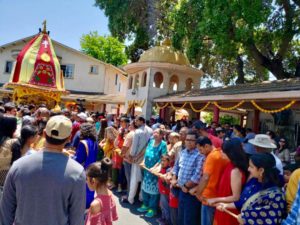
The symbolism of this ritual is that even though the king holds the highest position in the land, he still performs this menial service to god. In the eyes of the Lord, everyone is equal from the mightiest and richest king to the poorest and most humble commoner.
‘Chhera Pahara’ is performed on two days – when the Rath Yatra starts and on the way back, before the deities return to the main temple.
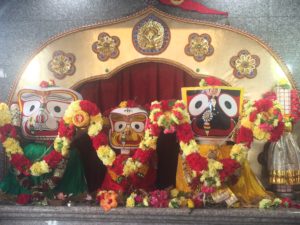 Dr Japra also smashed a coconut as an offering – an auspicious Hindu symbol of initiation – and the staircase to the Rath was taken aside. Devotees held the ropes on both sides and the Yatra (procession) began. Many wore no socks or shoes in the scorching heat of the pavement. Some devotees held on to the chariot at the sides while some gave it gentle pushes as they walked along.
Dr Japra also smashed a coconut as an offering – an auspicious Hindu symbol of initiation – and the staircase to the Rath was taken aside. Devotees held the ropes on both sides and the Yatra (procession) began. Many wore no socks or shoes in the scorching heat of the pavement. Some devotees held on to the chariot at the sides while some gave it gentle pushes as they walked along.
The chariot procession took three rounds of the parking lot with intermittent stops for more coconut offerings. Bhajans were sung on the way.
Finally, it came to rest near the entrance to the temple. Devotees carried the deities to the hall of the main temple and placed them on a dais.
This place symbolically represents the Gundicha Temple in Puri where the trio of deities is supposed to stay for seven days. Gundicha was the queen of King Indradyumna who built the Jagannath Temple and instituted the Rath Yatra. According to other folklore, Gundicha was a local goddess, symbolizing the sacred feminine.
Devotees sang bhajans amid chants of “Hare Rama Hare Krishna”. A leading lady asked the seated faithful to repeat the chant 12 times as it was the sacred mantra of the great devotee, Sri Chaitanya Mahaprabhu.
The priests offered ‘Mahaprasad’ (a sumptuous offering of different types of food) to the deities behind a curtain, and the priests performed an ‘aarti’ (offering made with lamps that are circled around the deities with the chanting of mantras and devotional songs) and blessed the devotees.
There was a lot of traditional Oriya food served such as besara, tomato khata, dali, etc. along with fruits, nuts and raisins and mung beans.
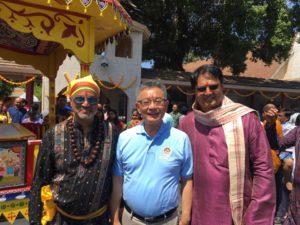 The deities arew brought back to the main temple after around nine days. On the way back, they stop at Mausi Maa Temple (their aunt’s place) where they are offered “Podha Pitha”, a local delicacy. The return procession is called Bahuda Yatra.
The deities arew brought back to the main temple after around nine days. On the way back, they stop at Mausi Maa Temple (their aunt’s place) where they are offered “Podha Pitha”, a local delicacy. The return procession is called Bahuda Yatra.
Bahuda Yatra at the Fremont Temple is scheduled for July 14.
Media outlets AB 24 represented by Sanjeev Bhardwaj, Sargam TV represented by Varinder Ubhi, Bharat Today USA, OurTripVideos, TV Asia and In Focus Photography covered the event.
